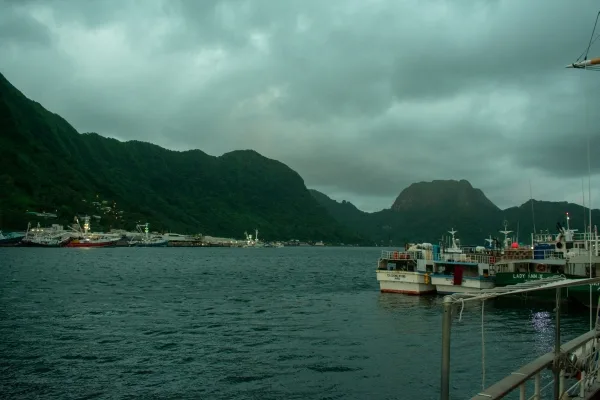Programs Blog
On the lookout

Joao Freitas, C-Watch, Colorado College
Ship’s Log
Current Position
16ᵒ08 S, 172ᵒ 02’W, South Pacific Ocean
Ship’s Heading and Speed
195ᵒ, 6 knots
Weather
Wind SE, Beaufort 4. 4 feet waves.
Yesterday we started our journey through the South Pacific. However, many little things matter when getting the ship in motion. We start by going over drills for the various emergencies that can occur while we are underway – man overboard, fire in the galley, and prepare to abandon ship. Each time we rehearse these scenarios, my heart cannot help to pound faster, because these are very specific skills we hope to never have to use, but are glad to have them on our sets just in case.
Upon finishing the drill, we finally got an opportunity to debrief and ready ourselves to get underway. You can sense the excitement filling up the air as the captain shouts commands to leave the dock. This excitement comes paired up with our cluelessness, as most of us have no idea what to do upon hearing these commands, so we follow the more experienced crew like chicks around the hens. As we successfully sail into the open ocean, American Samoa slowly shrinks to a speck in the horizon, to disappear completely overnight. The sky is clear and there’s opportunity for the chief mate to point at planets, stars and constellations. On deck a few of us would listen attentively with our chins pointing up. As the night rolls in and the dawn watch starts, most people take to their bunks to catch on some good sleep.
The morning starts with an amazing sunrise and a breakfast that would put any seasickness to bed (for some time anyway). As watch starts, we are greeted by the first flying fish I have seen in my life. My job is to stand on the forward deck, on lookout. This is possibly the only job aboard the Seamans that requires solely paying heed to your senses. One would consider it an easy task if it weren’t for our brains constantly trying to go on standby – we naturally try perceiving changes in state than the states themselves, it conserves our energies. But we must not let that happen while on lookout. In any case, it doesn’t stop it from being my favorite job so far, because much like seeing is a requirement, so is silence, which becomes a commodity hard to come by on a 134ft long brigantine inhabited by 32 people.
Class aboard becomes especially interesting when we are tired from our watch and all we want to do is getting some sleep in. But time does not stop, and neither does Mama Seamans. We learn the proper ways of gybing by doing it three or four times in an hour. By the end, it feels more rewarding than tiring, but we are more than ready for snacks.
American Samoa is long gone beneath the horizon, and we find ourselves roughly halfway to Vava’u, in the Kingdom of Tonga. Soon enough you’ll be hearing from the other shipmates on more adventures in the days ahead.
– Joao Freitas, C-Watch, Colorado College
Recent Posts from the Ships
- Ocean Classroom 2024-A collaborative high school program with Proctor Academy
- Collaborations and Long-term Commitments: SEA’s Caribbean Reef Program Sets a Course for Coastal Programs that Compliment Shipboard Experiences.
- Sea Education Association students prepare for life underway using state of the art nautical simulation from Wartsila Corporation.
- SEA Writer 2022, Magazines From the Summer SEA Quest Students
- Technology@SEA: Upgrades Allow Insight into Ocean Depths
Programs
- Gap Year
- Ocean Exploration
- High School
- Science at SEA
- SEA Expedition
- SEAScape
- Pre-College
- Proctor Ocean Classroom
- Protecting the Phoenix Islands
- SPICE
- Stanford@SEA
- Undergraduate
- Climate and Society
- Climate Change and Coastal Resilience
- Coral Reef Conservation
- Marine Biodiversity and Conservation
- MBL
- Ocean Exploration: Plastics
- Ocean Policy: Marine Protected Areas
- Oceans and Climate
- Pacific Reef Expedition
- The Global Ocean: Hawai'i
- The Global Ocean: New Zealand